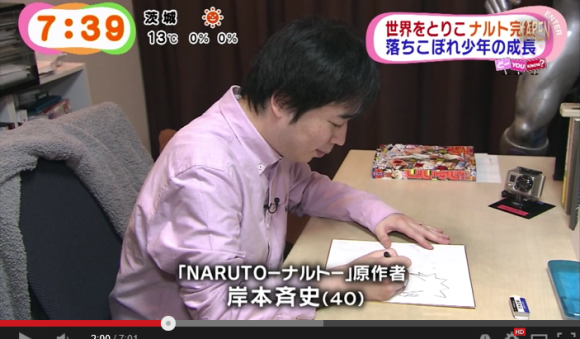
The serialized nature of manga means booming success can really sneak up on artists and publishers alike. When Masashi Kishimoto turned in his pages for the very first chapter of his new series Naruto back in 1999, he probably didn’t know he was about to create one of the most popular manga ever, but that’s exactly what he did.
Kishimoto didn’t just earn himself 15 solid years of steady work, though, but also the continual march of tight deadlines that come with writing and drawing a hit manga. Despite being one of the biggest names in the industry, Kishimoto had only found time to give one TV interview during Naruto’s serialization, but now that the series has finally come to a close, he’s appeared before the camera again, in a special interview held in the studio where he put pen to paper and brought one of Japan’s most beloved comics to life.
Fuji TV’s Mezamashi TV morning talk show recently sent on-air personality and idol singer Rina Ikoma to visit Kishimoto’s studio.
The good-natured and gallant manga artist gave her a warm greeting, and even offered her a handful of tissues when Ikoma, who’s previously dabbled in Naruto cosplay, teared up from the emotion caused be where she was and who she was talking with.
▼ Kishimoto
In contrast to the colorful and energetic art that characterizes his series, Kishimoto’s workspace is well-organized and sparsely furnished. There aren’t any racks of ninja uniforms or shuriken sticking out of the walls, and the only glaring anime accent is the glaring statue of Dragon Ball Z’s Frieza standing watch over Kishimoto’s personal desk.
Frieza’s reputed managerial skills notwithstanding, the entire comic wasn’t produced under his watchful eye, though. Kishimoto admits with a laugh the he received the statue as a gift, and specifically set it out after Mezamashi TV said they’d be coming for an interview, since the studio doesn’t really have any permanent interior installments with much dramatic impact. We’re sure his team of assistants appreciate their spacious desks and comfy chairs more than decorations with visual flair, anyway.
Aside from the neatly arranged art supplies, another tip-off that this is a manga studio is the large stack of Naruto collected volumes on Kishimoto’s desk. They aren’t there so he can smugly look over his past successes, though, but as reference materials. “Sometimes, I don’t remember certain characters or their exact designs so well,” he admits, shedding light on one of the difficulties of a 700-chapter epic. As a matter of fact, the series became so long that this analogue search method wasn’t always the most efficient, as Kishimoto comments it’s actually faster to just look up the information he needs on the Internet.
▼ We’re here if you need us, Mr. Kishimoto!
Speaking of character designs, during the interview Kishimoto lets viewers in on a little secret. The manga original had been running for about three years when the Naruto anime started. Wanting to make the manga as accessible as possible for fans who say the anime version first, and also vice-versa, Kishimoto made a conscious effort to shift his drawing style so that his art more closely resembled that of the anime series after its premiere in 2002.
The artist also opens up about his love life. When asked if any of his personal experiences influenced scenes in the upcoming The Final -Naruto the Movie- theatrical feature, Kishimoto recalls the staff talking about the believability of a scene where a girl knits a muffler for the titular ninja. “’Do girls still do that in this day and age?’ someone asked, and I said, ‘Actually, my wife made a scarf for me…’ The room got really quiet after that.”
Finally, Ikoma asks about the decision to give Naruto, a Japanese ninja, blond hair. “The original world view of the manga was ‘Japan as seen by other countries,’” Kishimoto explains. Not being bound by reality, he “wanted to do something unusual, that would stand out and make people take notice.”
With 200 million copies of Naruto sold around the world so far, we’d say he succeeded.

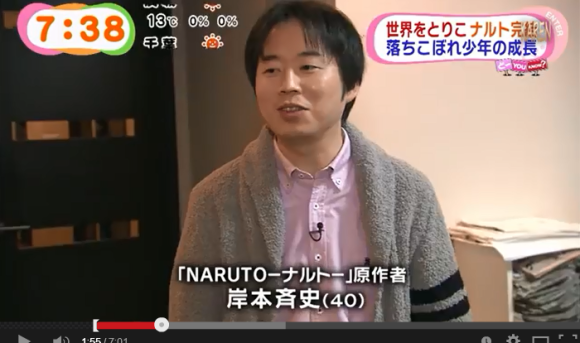
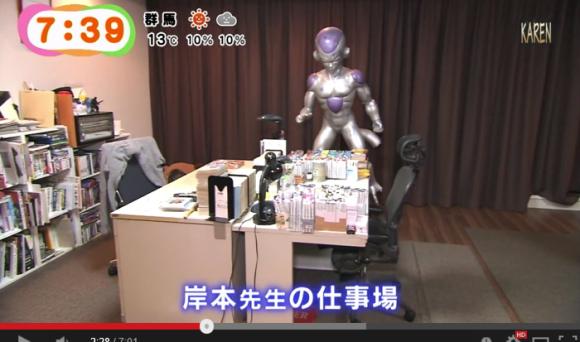
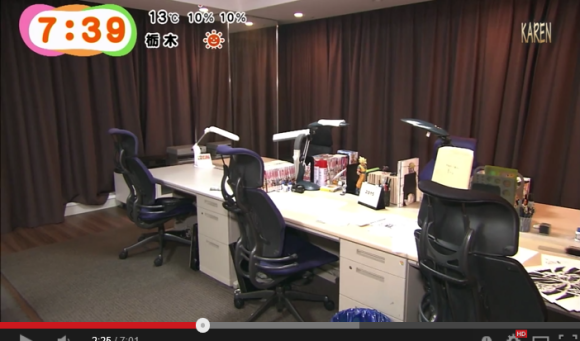
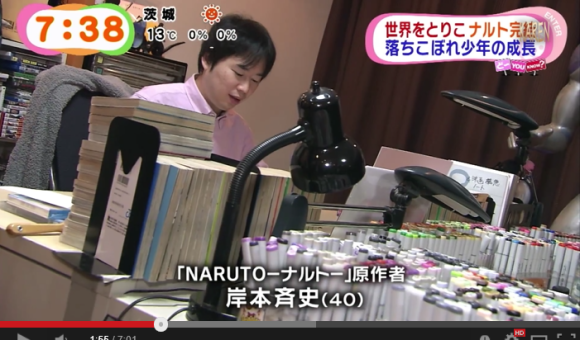
 Believe it! After 15 years of ninja action, manga Naruto is ending next month
Believe it! After 15 years of ninja action, manga Naruto is ending next month Believe it! Naruto’s creator Masashi Kishimoto comments on plans for new manga at New York event
Believe it! Naruto’s creator Masashi Kishimoto comments on plans for new manga at New York event Naruto themed cafe in Akihabara is where all the ninjas eat
Naruto themed cafe in Akihabara is where all the ninjas eat Naruto art exhibition coming to Tokyo and Osaka with free, new manga for all attendees
Naruto art exhibition coming to Tokyo and Osaka with free, new manga for all attendees Naruto creator Masashi Kishimoto is indeed working on his new story for Weekly Shonen Jump
Naruto creator Masashi Kishimoto is indeed working on his new story for Weekly Shonen Jump Japanese beef bowl chain Sukiya’s 2026 Smile Box lucky bag basically pays for itself
Japanese beef bowl chain Sukiya’s 2026 Smile Box lucky bag basically pays for itself Should you dip your cake in sake? One Japanese brewer says no, but actually yes【 Taste test】
Should you dip your cake in sake? One Japanese brewer says no, but actually yes【 Taste test】 What did Shibuya really look like after the crowds on New Year’s Day?
What did Shibuya really look like after the crowds on New Year’s Day? McDonald’s unveils latest Black Burger – the Spicy Korean Burger 【Video】
McDonald’s unveils latest Black Burger – the Spicy Korean Burger 【Video】 Melon topped with ice cream: two great Hokkaido tastes in one crazily delicious package
Melon topped with ice cream: two great Hokkaido tastes in one crazily delicious package Japan’s new difficult-to-drink-from beer glass protects your liver, but it’s a brutal experience
Japan’s new difficult-to-drink-from beer glass protects your liver, but it’s a brutal experience 7-Eleven’s edible cat paw proves Japanese convenience store sweets are on a whole other level
7-Eleven’s edible cat paw proves Japanese convenience store sweets are on a whole other level Pikachu-ear engagement rings and Pokémon wedding rings for him and her can now be yours【Photos】
Pikachu-ear engagement rings and Pokémon wedding rings for him and her can now be yours【Photos】 The etiquette rules for visiting Shinto shrines in Japan
The etiquette rules for visiting Shinto shrines in Japan Japan Super Budget Dining – What’s the best way to spend 1,000 yen at beef bowl chain Sukiya?
Japan Super Budget Dining – What’s the best way to spend 1,000 yen at beef bowl chain Sukiya? Starbucks Japan ready to get Year of the Horse started with adorable drinkware and plushies【Pics】
Starbucks Japan ready to get Year of the Horse started with adorable drinkware and plushies【Pics】 Hayao Miyazaki says Happy New Year to Studio Ghibli fans with new art for Year of the Horse
Hayao Miyazaki says Happy New Year to Studio Ghibli fans with new art for Year of the Horse 7 great places to see Mt. Fuji from without having to climb it
7 great places to see Mt. Fuji from without having to climb it We found possibly the quietest Japanese-style hotel in Tokyo’s bustling Shinjuku district
We found possibly the quietest Japanese-style hotel in Tokyo’s bustling Shinjuku district Cup Noodle tries an authentic Jiro-style ramen, but something’s not quite right
Cup Noodle tries an authentic Jiro-style ramen, but something’s not quite right Hello Kitty Choco Egg figures are an adorable trip through three periods of Japanese pop culture【Pics】
Hello Kitty Choco Egg figures are an adorable trip through three periods of Japanese pop culture【Pics】 Japan’s oldest largetooth sawfish in captivity back on display in Mie Prefecture
Japan’s oldest largetooth sawfish in captivity back on display in Mie Prefecture Cyberpunk anime meets traditional culture in Ghost in the Shell gold leaf Japanese changing screens
Cyberpunk anime meets traditional culture in Ghost in the Shell gold leaf Japanese changing screens The best Starbucks Japan Frappuccinos we want to drink again in 2026
The best Starbucks Japan Frappuccinos we want to drink again in 2026 We revisited Sweets Paradise after a decade to see if Japan’s dessert buffet still delivers
We revisited Sweets Paradise after a decade to see if Japan’s dessert buffet still delivers 7-Eleven Japan starts new temporary luggage storage service in over 300 branches
7-Eleven Japan starts new temporary luggage storage service in over 300 branches Disillusionment at Tsukiji’s tourist-target prices led us to a great ramen restaurant in Tokyo
Disillusionment at Tsukiji’s tourist-target prices led us to a great ramen restaurant in Tokyo Starbucks teams up with 166-year-old Kyoto doll maker for Year of the Horse decorations【Photos】
Starbucks teams up with 166-year-old Kyoto doll maker for Year of the Horse decorations【Photos】 Tokyo considering law requiring more trash cans following litter increase in heavily touristed area
Tokyo considering law requiring more trash cans following litter increase in heavily touristed area Tokyo’s Tsukiji sushi neighborhood asks tour groups to stay away for the rest of the month
Tokyo’s Tsukiji sushi neighborhood asks tour groups to stay away for the rest of the month Tokyo event lets you travel back in time, for free, to celebrate 100 years since Showa era start
Tokyo event lets you travel back in time, for free, to celebrate 100 years since Showa era start Sanrio theme park in Japan announces plans to expand into a Sanrio resort
Sanrio theme park in Japan announces plans to expand into a Sanrio resort Japan may add Japanese language proficiency, lifestyle classes to permanent foreign resident requirements
Japan may add Japanese language proficiency, lifestyle classes to permanent foreign resident requirements Stamina-destroying “Paralysis Noodles” are Tokyo’s newest over-the-top ramen innovation
Stamina-destroying “Paralysis Noodles” are Tokyo’s newest over-the-top ramen innovation Survey asks foreign tourists what bothered them in Japan, more than half gave same answer
Survey asks foreign tourists what bothered them in Japan, more than half gave same answer Japan’s human washing machines will go on sale to general public, demos to be held in Tokyo
Japan’s human washing machines will go on sale to general public, demos to be held in Tokyo Japan’s deadliest food claims more victims, but why do people keep eating it for New Year’s?
Japan’s deadliest food claims more victims, but why do people keep eating it for New Year’s? We deeply regret going into this tunnel on our walk in the mountains of Japan
We deeply regret going into this tunnel on our walk in the mountains of Japan Studio Ghibli releases Kodama forest spirits from Princess Mononoke to light up your home
Studio Ghibli releases Kodama forest spirits from Princess Mononoke to light up your home Major Japanese hotel chain says reservations via overseas booking sites may not be valid
Major Japanese hotel chain says reservations via overseas booking sites may not be valid Put sesame oil in your coffee? Japanese maker says it’s the best way to start your day【Taste test】
Put sesame oil in your coffee? Japanese maker says it’s the best way to start your day【Taste test】 No more using real katana for tourism activities, Japan’s National Police Agency says
No more using real katana for tourism activities, Japan’s National Police Agency says Starbucks Japan reveals new sakura drinkware collection, inspired by evening cherry blossoms
Starbucks Japan reveals new sakura drinkware collection, inspired by evening cherry blossoms Updated cherry blossom forecast shows extra-long sakura season for Japan this year
Updated cherry blossom forecast shows extra-long sakura season for Japan this year Naruto’s dad is star of new manga drawn and written by creator Masashi Kishimoto
Naruto’s dad is star of new manga drawn and written by creator Masashi Kishimoto Attention: The cast of Naruto is now cats【Photos】
Attention: The cast of Naruto is now cats【Photos】 Naruto’s son gets a voice as lead roles cast for Boruto –Naruto the Movie-
Naruto’s son gets a voice as lead roles cast for Boruto –Naruto the Movie- Naruto fans turn message maker system’s interface lemons into ninja lemonade with awesome artwork
Naruto fans turn message maker system’s interface lemons into ninja lemonade with awesome artwork World celebrates ninja manga Naruto’s 18th anniversary with “Naruto Runs”
World celebrates ninja manga Naruto’s 18th anniversary with “Naruto Runs” The countdown’s begun — something exciting is brewing for Naruto fans!
The countdown’s begun — something exciting is brewing for Naruto fans! There’s a touching reason it took so long for samurai and ninja to show up in One Piece
There’s a touching reason it took so long for samurai and ninja to show up in One Piece Naruto’s son speaks in new teaser for Boruto –Naruto the Movie- anime film 【Video】
Naruto’s son speaks in new teaser for Boruto –Naruto the Movie- anime film 【Video】 Naruto and Teenage Mutant Ninja Turtles joining forces for crossover comic book series
Naruto and Teenage Mutant Ninja Turtles joining forces for crossover comic book series Naruto’s author Kishimoto reveals what characters’ names would’ve been if editor didn’t intervene
Naruto’s author Kishimoto reveals what characters’ names would’ve been if editor didn’t intervene Naruto Manga Gets Kabuki Play in August 2018
Naruto Manga Gets Kabuki Play in August 2018 Believe it! Naruto live-action stage play returns, shows off huge new cast and costumes【Photos】
Believe it! Naruto live-action stage play returns, shows off huge new cast and costumes【Photos】 Boruto -Naruto the Movie- film’s main staff, illustrated poster revealed
Boruto -Naruto the Movie- film’s main staff, illustrated poster revealed Japan’s most successful manga artists draw their characters for the camera 【Video】
Japan’s most successful manga artists draw their characters for the camera 【Video】 J-World Tokyo: One Piece, Naruto and Dragon Ball Attractions at Shonen Jump Manga Theme Park!
J-World Tokyo: One Piece, Naruto and Dragon Ball Attractions at Shonen Jump Manga Theme Park!
Leave a Reply